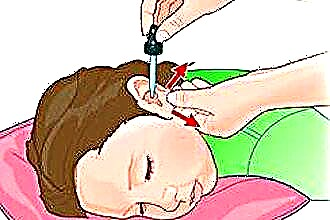Treatment of sinusitis during pregnancy must be carried out under the supervision of a physician. Since there are a large number of different methods of dealing with inflammation of the maxillary sinuses (from rinsing the nose at home to antibiotic therapy and puncture), only a specialist can choose the appropriate therapy. Usually, how to treat sinusitis is influenced by the presence or absence of certain symptoms in the patient, as well as the duration of pregnancy. Only after examination, the otolaryngologist can determine the form and severity of the disease and prescribe therapy of the appropriate intensity.
How the immune system works during pregnancy
 During the carrying of a child, numerous changes occur in a woman's body, including hormonal ones. Since the fetus receives 50% of the genetic information from the father, immediately after conception, the woman begins to produce special hormones that protect the embryo from the attacks of the immune system and prevent the body from rejecting cells foreign to it. However, this partially suppresses the specific (acquired) immunity of the pregnant woman. As a result, the woman's body is protected mainly only by nonspecific (innate) immunity, as a result of which it becomes more susceptible to viruses and infections. The risk of exacerbation of chronic diseases is also significantly increased.
During the carrying of a child, numerous changes occur in a woman's body, including hormonal ones. Since the fetus receives 50% of the genetic information from the father, immediately after conception, the woman begins to produce special hormones that protect the embryo from the attacks of the immune system and prevent the body from rejecting cells foreign to it. However, this partially suppresses the specific (acquired) immunity of the pregnant woman. As a result, the woman's body is protected mainly only by nonspecific (innate) immunity, as a result of which it becomes more susceptible to viruses and infections. The risk of exacerbation of chronic diseases is also significantly increased.
Often, rhinitis (runny nose) is attributed to vasodilation (due to increased blood circulation) or an increase in the total amount of mucous secretions from the body, characteristic of expectant mothers. However, pregnant women should pay special attention to any, even the most insignificant, ailments, such as ordinary nasal congestion. Due to weakened immunity, the body cannot always cope with the disease on its own, and a prolonged lack of adequate treatment for ARVI often leads to complications in the form of inflammation in the maxillary sinuses. At the same time, the treatment of sinusitis in pregnant women is complicated by numerous contraindications to the use of potent drugs, especially during the first trimester.
Symptoms of sinusitis
It is necessary to start treating sinusitis during pregnancy as early as possible. Firstly, the detection of this disease in the early stages avoids such serious complications as meningitis, sepsis, neuritis of the facial nerve, disturbances in the functioning of the organs of hearing and vision, etc. Secondly, timely detection and treatment of the disease eliminates the need to take potent drugs that can adversely affect the development of the embryo.
In order not to miss the moment and start therapy on time, you need to be able to distinguish between the main symptoms of maxillary sinusitis.
Viral sinusitis in most cases develops against the background of ARVI. The fact is that, together with the air, the virus enters not only the nasal cavity, but also the accessory sinuses, as a result of which edema occurs there and mucus begins to be produced. However, no specific treatment is required in this situation. This type of sinusitis does not have any special external manifestations, except for nasal congestion, and will pass along with a cured cold.
However, if you let ARVI go on its own, then the fistula - a small hole connecting the sinus with the nasal cavity, can be blocked due to swelling of the mucous membrane. As a result, the accumulated mucus will not have a path for outflow and inside the closed space of the sinus there will be favorable conditions for the reproduction of bacteria. In addition, the disease may initially be bacterial in nature. In these cases, even during pregnancy, the treatment of sinusitis cannot do without antibiotic therapy. With bacterial (purulent) sinusitis, nasal congestion and partial loss of smell are accompanied by the following symptoms:
- greenish or yellowish nasal discharge that has a foul odor;
- headache pain that worsens when turning and tilting the head;
- pain on palpation in the area of the maxillary sinuses;
- feeling of pressure and pain in the bridge of the nose;
- subfebrile temperature (37.1-38 degrees).
Drug therapy
During pregnancy, any drug therapy is considered undesirable because it can adversely affect the development of the fetus.
However, if we are talking about bacterial maxillary sinusitis, then it is almost impossible to avoid the use of antibiotics (an exception can be made only by patients during the first trimester, if the disease has not become severe). The need to take antibacterial drugs usually scares patients, but the negative consequences of such treatment are too exaggerated. Now there are quite a few non-toxic and not too aggressive drugs that are able to cope with pathology and at the same time not harm the child.
By itself, taking correctly selected antibiotics usually causes a minimum number of side effects, but an independent dose reduction or interruption of the course of antibiotic therapy in order to protect the fetus from negative effects can lead to serious problems (the acquisition of antibiotic resistance by bacteria, relapse or chronicity of the disease, etc. .). During antibiotic therapy, you must strictly follow the doctor's instructions. In addition, it is imperative to check the dosage and contraindications indicated in the instructions for the drug. You should also know that the possibility or impossibility of using a drug often depends on the duration of pregnancy (the same drug can have a different effect on the body depending on the trimester).
 If the severity of the disease is not too high, then specialists may limit themselves to prescribing topical antibiotics (drops, sprays). In this case, the medicine enters directly into the focus of infection (maxillary sinuses), bypassing the gastrointestinal tract. If in order to cure sinusitis more effective treatment is needed, then systemic antibiotics are prescribed in the form of tablets:
If the severity of the disease is not too high, then specialists may limit themselves to prescribing topical antibiotics (drops, sprays). In this case, the medicine enters directly into the focus of infection (maxillary sinuses), bypassing the gastrointestinal tract. If in order to cure sinusitis more effective treatment is needed, then systemic antibiotics are prescribed in the form of tablets:
- Penicillin (Amoxiclav, Flemoxin solutab). Relatively easily tolerated by the body, without causing side effects and without negatively affecting the development of the fetus. The disadvantage of these drugs is that many pathogenic organisms have already acquired resistance to them.
- Macrolides (Macropen, Sumamed). Used in case of intolerance or ineffectiveness of penicillin antibiotics.
- Cephalosporins (Cefuroxime, Ceftriaxone). Stronger remedies, which are usually indicated for severe inflammatory processes.
In order to effectively treat sinusitis during pregnancy, it is often necessary to resort to the use of vasoconstrictor nasal drops. Their use is necessary to establish normal air exchange, since hypoxia can lead to disturbances in the development of the embryo. The course of taking such drops usually does not exceed 3-5 days. In addition, in addition to antibiotics, specialists often prescribe the herbal medicine Sinupret for expectant mothers. It helps to thin mucus, has anti-inflammatory and decongestant effects, and increases the effectiveness of antibiotic therapy. In addition, if sinusitis in pregnant women is caused by an allergic reaction of the body, then they are usually prescribed antihistamines.
Puncture
In many countries of the world, the puncture has long ceased to be used for therapeutic purposes.However, domestic medicine still considers this procedure as one of the methods for treating maxillary sinusitis. Moreover, a puncture can serve as an answer to the question "what to do and how to cure bacterial sinusitis during the first trimester of pregnancy?" During this period, any drug treatment is highly undesirable, therefore, puncture becomes the optimal way out of the situation.
If pus has accumulated in the maxillary sinuses of a pregnant woman, a puncture of the inner wall of the sinus is made under local anesthesia using a special thin needle. A small opening makes possible the outflow of mucopurulent masses. After pumping out the pathological exudate, otolaryngologists inject saline into the sinus. Also, in especially severe forms of the course of the disease (when, for various reasons, bacteria do not respond to antibacterial drugs), puncture can be used as a diagnostic method. Making a puncture, the doctor takes a sample of the exudate for its detailed study and the subsequent appointment of adequate treatment.
Yamik catheter treatment
When treating sinusitis during pregnancy, a Yamik catheter can be a good alternative to surgery (puncture). The essence of the procedure consists in the suction of pathological secretions from the maxillary cavity without violating its integrity and damaging the mucous membrane (the mechanism is made of soft latex material). The procedure is based on the use of the pressure difference created in the nasal cavity.
The mechanism itself consists of two parts: a body and a cuff. The body includes a rear balloon and a valve for inflation, a cuff - a front balloon with an inflation valve, as well as a working channel and an adapter for a syringe. During the procedure, the patient must be in a sitting position, and before starting the manipulation, she is given local anesthesia. The catheter is then inserted into the nasal passage and the posterior balloon is inflated to close off the nasopharynx. The anterior balloon, in turn, is inflated in the nasal cavity, creating a vacuum inside.
As a result of the creation of negative pressure, the sinuses open and the mucopurulent masses enter the nasal cavity, from where they are successfully removed using a syringe attached to the cuff. The procedure is repeated until pathological discharge ceases to flow into the syringe. However, one session should not last longer than eight minutes.
It should also be borne in mind that treatment with a Yamik catheter is contraindicated in pregnant women suffering from hemorrhagic vasculitis and nasal polyposis.



